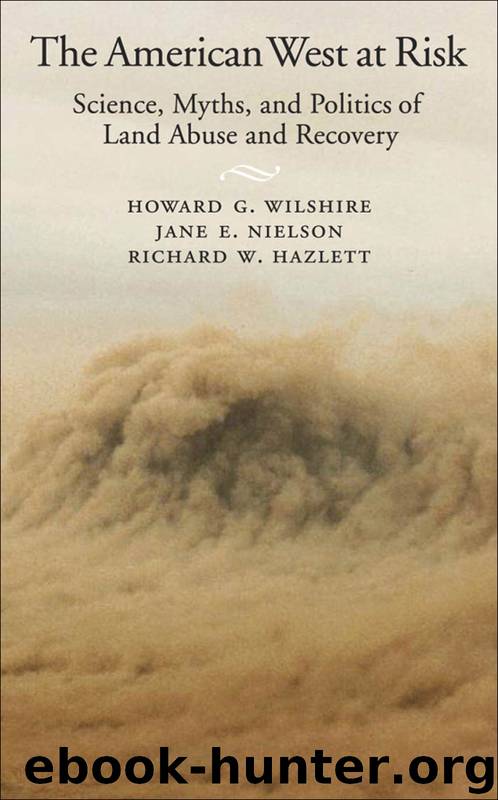American West at Risk by Wilshire Howard G.; Nielson Jane E.; Hazlett Richard W. & Jane E. Nielson & Richard W. Hazlett

Author:Wilshire, Howard G.; Nielson, Jane E.; Hazlett, Richard W. & Jane E. Nielson & Richard W. Hazlett
Language: eng
Format: epub
Publisher: Oxford University Press, USA
Published: 2008-04-04T04:00:00+00:00
The fearful link
The United States mines uranium mainly from sedimentary deposits in 5 of the 11 western states.78 Dangerous underground uranium mining (see chapter 7) ended in 1992, and ores now come out of open pits. The ores are either leached in place or in heaps to extract the uranium. The United States is estimated to have 112,000 tons of known recoverable uranium at $36 per pound—enough for seven to eight years with no rise in consumption. Increased prices and improved reactor efficiencies could substantially extend the resource’s life, while building more nuclear power plants will shorten it.
Proven world uranium reserves could provide approximately a 52-year supply for today’s conventional reactors, assuming no growth in consumption.79 The richest uranium lodes have been found and exploited, and the lower grade ores now require much larger energy inputs per pound to produce and process (see chapter 4). Claims that a virtually limitless supply can be produced from ocean seawater and unmineralized rocks ignore the prohibitive energy costs of extracting uranium from common rocks and the vast environmental impacts of mining our back yards.80
India and Israel acquired their nuclear arsenals by reprocessing byproduct plutonium from power plants, and the more politically unstable Pakistan and North Korea, and perhaps Iran, have based or will base their nuclear weapons programs on highly enriched uranium from facilities that produce uranium power plant fuel. Until the 1980s, the United States had intended to extract plutonium from breeder reactors, but the power plant–to–atom bomb linkage led western nations to abandon that plan, hoping to restrain nuclear weapons proliferation.81 In addition, the breeder process yields plutonium very slowly. It reaches the point of energy break-even—when more fuel has been produced than consumed—only after decades of operation.82
Post-Cold War U.S.–Russian agreements to disassemble nuclear warheads could supply highly enriched uranium for power plant fuel. But instead of turning the bombs into peaceful fuels, the U.S. government decided instead to store decommissioned warheads. As a result, three of nine types of nuclear weapons, all designed during the Cold War, have had their useful lifetimes extended by 30 years (over the designed 20 years) at a very high price.83
Download
This site does not store any files on its server. We only index and link to content provided by other sites. Please contact the content providers to delete copyright contents if any and email us, we'll remove relevant links or contents immediately.
| Automotive | Engineering |
| Transportation |
Whiskies Galore by Ian Buxton(41525)
Introduction to Aircraft Design (Cambridge Aerospace Series) by John P. Fielding(32885)
Small Unmanned Fixed-wing Aircraft Design by Andrew J. Keane Andras Sobester James P. Scanlan & András Sóbester & James P. Scanlan(32570)
Craft Beer for the Homebrewer by Michael Agnew(17930)
Turbulence by E. J. Noyes(7694)
The Complete Stick Figure Physics Tutorials by Allen Sarah(7135)
Kaplan MCAT General Chemistry Review by Kaplan(6591)
The Thirst by Nesbo Jo(6432)
Bad Blood by John Carreyrou(6271)
Modelling of Convective Heat and Mass Transfer in Rotating Flows by Igor V. Shevchuk(6219)
Learning SQL by Alan Beaulieu(6030)
Weapons of Math Destruction by Cathy O'Neil(5824)
Man-made Catastrophes and Risk Information Concealment by Dmitry Chernov & Didier Sornette(5643)
Digital Minimalism by Cal Newport;(5388)
Life 3.0: Being Human in the Age of Artificial Intelligence by Tegmark Max(5182)
iGen by Jean M. Twenge(5158)
Secrets of Antigravity Propulsion: Tesla, UFOs, and Classified Aerospace Technology by Ph.D. Paul A. Laviolette(4982)
Design of Trajectory Optimization Approach for Space Maneuver Vehicle Skip Entry Problems by Runqi Chai & Al Savvaris & Antonios Tsourdos & Senchun Chai(4837)
Electronic Devices & Circuits by Jacob Millman & Christos C. Halkias(4743)
